Special Feature: Products Sally Recommends
Top Ten Cities For You and Your Kids: New Orleans, Louisiana
I’ve heard for years that Christmas in New Orleans is a magical time. Concerts, special menus, revelry...wait a minute, don’t the revels commence daily in this most festive of American cities? No matter, I’ve been looking for a reason to take our son, Steven, to The Big Easy so I pack him and the husband up and we head south for the holidays. As expected, our days and nights are punctuated by the holy trinity of art, music and food.
Monday
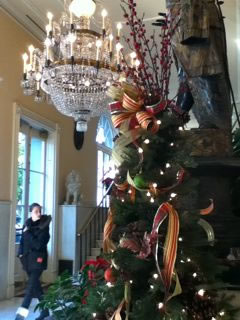 Arriving in New Orleans, I’m struck by how kids love bling. If it’s bright and shiny – ding ding ding! Our hotel, the Omni Royal Orleans, does not disappoint. A gleaming marble staircase transports us to the front desk, where a massive twinkling chandelier lords overhead. To our left, a wall of mirrors serves to enhance the row of chandeliers that lead to the hotel restaurant. We drop our bags off with the amiable bellhop and head to Cafe du Monde, a place I’ve dreamed about since my last visit.
Arriving in New Orleans, I’m struck by how kids love bling. If it’s bright and shiny – ding ding ding! Our hotel, the Omni Royal Orleans, does not disappoint. A gleaming marble staircase transports us to the front desk, where a massive twinkling chandelier lords overhead. To our left, a wall of mirrors serves to enhance the row of chandeliers that lead to the hotel restaurant. We drop our bags off with the amiable bellhop and head to Cafe du Monde, a place I’ve dreamed about since my last visit.
Cafe du Monde is known for its beignets, squared-off donuts dusted (smothered?) in powdered sugar, and the chicory-laced coffee served alongside. The menu at this expansive, French-flavored cafe is as compact as the tables:
Order of Three Beignets ($2.14)
Cafe au Lait ($2.14/$3.64)
Hot Chocolate ($2.14/$3.64)
Since the cafe is packed at 11 a.m. and a line runs down the block, we opt for the take-out window. Hubby Fen agrees to wait while Steven and I press our noses against a window that looks onto the donut-making process. Thin sheets of dough are rolled along a conveyor belt until a metallic contraption cuts them into rows of two-inch squares. A burly man proceeds to rip the squares apart and toss them over his shoulder into a mammoth fryer. The actual frying is left to a much smaller man, who sloshes the donuts through hot oil until they’re puffed up. Once done, the pillows are napped in powdered sugar.
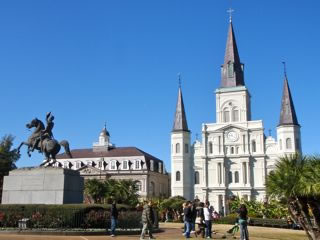 We take our piping-hot donuts and warm beverages across the street to Jackson Square, the heart and soul of the city’s French Quarter. An iconic statue of Andrew Jackson on horseback is at the center of the Square, which is ringed by magnolias, palm trees and tall evergreens. There are benches everywhere, people walk to and fro and the sun is shining on this cold winter day. Duly sated, we exit through wrought iron gates and are greeted by The Smoking Time Jazz Club, a seven-man band pumping out lively jazz in the middle of the street.
We take our piping-hot donuts and warm beverages across the street to Jackson Square, the heart and soul of the city’s French Quarter. An iconic statue of Andrew Jackson on horseback is at the center of the Square, which is ringed by magnolias, palm trees and tall evergreens. There are benches everywhere, people walk to and fro and the sun is shining on this cold winter day. Duly sated, we exit through wrought iron gates and are greeted by The Smoking Time Jazz Club, a seven-man band pumping out lively jazz in the middle of the street.
“We’ve been playing together since summer and we’ll play any corner [in the Quarter],” chirps the lead singer.
After one set, we make our way to St. Louis Cathedral, which is blessedly open. The ornate church is elegant without being ostentatious, a checkerboard-square floor winking at a colorful mural overhead while a procession of stained-glass windows guards the periphery. There are Christmas decorations throughout and a sweet creche is front and center. There has been a house of worship here since 1718 and it’s a window on the area’s tumultuous past. A French king gave the colony to a Spanish king to keep it out of British hands but the French revolted, having no interest in becoming Spaniards. The Louisiana Purchase finally brought some peace and natives and visitors alike have found solace in the Cathedral ever since.
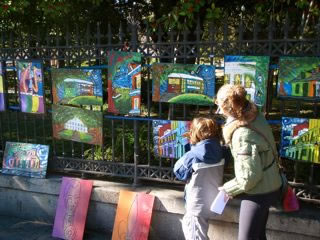 Exiting the Cathedral, I shepherd my men back around Jackson Square, the better to ogle the fanciful artwork that hangs on the wrought iron fencing enclosing the Square. We pause at the paintings of Alan Minor, a New Orleans native who’s been painting for 27 years. The brightly-colored pieces are acrylic on wood and I’m enchanted by one depicting the St. Charles Streetcar since my son is obsessed with all forms of transport. Other pieces show the French Quarter by day and by night and a painting of Oak Alley Plantation, forty miles away on the River Road, captivates Steven. An abstract rendering of a saxophone player is especially dear to the artist.
Exiting the Cathedral, I shepherd my men back around Jackson Square, the better to ogle the fanciful artwork that hangs on the wrought iron fencing enclosing the Square. We pause at the paintings of Alan Minor, a New Orleans native who’s been painting for 27 years. The brightly-colored pieces are acrylic on wood and I’m enchanted by one depicting the St. Charles Streetcar since my son is obsessed with all forms of transport. Other pieces show the French Quarter by day and by night and a painting of Oak Alley Plantation, forty miles away on the River Road, captivates Steven. An abstract rendering of a saxophone player is especially dear to the artist.
“My first instrument was the cello but my mom kept telling me to practice and all I wanted to do was play!” says Minor, laughing. “Once my mom put a saxophone in my hand, it stuck.” A fine arts major, Minor eventually traded the sax for a brush. As a member of the Jackson Square Artists Committee, he ensures that all of the artwork sold “on the fence” is original, with no reproductions or prints allowed.
“Over 250 artists [are allowed to sell] on the fence and it’s busiest on weekends, when 150-200 can be out selling their work.”
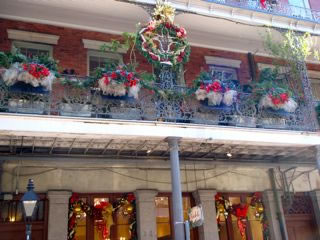 I spend a good bit of time trying to decide between two paintings and, unable to choose, commit to returning later. Our leisurely pace has me rethinking our itinerary, packed as it is with planned visits to the Aquarium of the Americas, the Insectarium and the National World War II Museum. Recalling a local’s suggestion to “take it easy – you’re in The Big Easy!” I pivot and suggest we continue our stroll around the Quarter. Walking up Royal Street and down Chartres, across St. Louis, Toulouse and St. Peter Streets, we are struck by the many wrought iron balconies decked out in garlands, bows and other holiday finery (and yes, the fleur-de-lys now closely associated with the New Orleans Saints is in ample evidence, black ‘n gold giving red ‘n green a run for its money). It all sparkles in the winter sun.
I spend a good bit of time trying to decide between two paintings and, unable to choose, commit to returning later. Our leisurely pace has me rethinking our itinerary, packed as it is with planned visits to the Aquarium of the Americas, the Insectarium and the National World War II Museum. Recalling a local’s suggestion to “take it easy – you’re in The Big Easy!” I pivot and suggest we continue our stroll around the Quarter. Walking up Royal Street and down Chartres, across St. Louis, Toulouse and St. Peter Streets, we are struck by the many wrought iron balconies decked out in garlands, bows and other holiday finery (and yes, the fleur-de-lys now closely associated with the New Orleans Saints is in ample evidence, black ‘n gold giving red ‘n green a run for its money). It all sparkles in the winter sun.
Hunger calling, we duck into the Gumbo Shop. It’s late afternoon and the cozy dining room is packed with chatty patrons. We order gumbo, jambalaya, red beans and rice and shrimp creole and are smitten with the local food. My seafood and okra gumbo is a puddle of deep brown goodness and we discreetly fight over each other’s plates. Reenergized, we return to Alan Minor’s paintings and purchase the two that will help us remember New Orleans best.
Entering the St. Pierre Suite at the Omni Royal Orleans is another example of the city’s welcoming embrace. Our two-room suite features a master bedroom with graceful king bed and plentiful space. Steven will camp out in the expansive Living Room with its sleeper sofa and no one will fight over the television since we have two. The shower in each bathroom benefits from having the Mississippi River close by – can you say power? Families will love this accommodation and the hotel boasts the best location in the French Quarter, bar none. Come Summer 2011, the hotel commences a top-to-bottom renovation. The traditional elegance of old-world New Orleans stays in place, with shades of blue, brown, crimson and gold refreshing every space.
Taking a stroll toward bustling Canal Street at twilight, we pass a number of galleries and antique shops on Royal and pause at an antique gun and sword store that proves irresistible to Steven. The Carousel Bar at the Hotel Monteleone is packed with merry revelers and much as we’d love a seat at the rotating, carousel-themed bar, there is none to be had so we make our way back to the Omni’s Rib Room Bar. Somehow, pre-dinner drinks make sense.
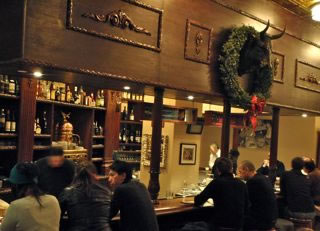 Our evening meal is at Luke, a French-German brasserie opened by John Besh, a rising chef who already possesses a prestigious James Beard Award. The wood trim, parquet flooring and husky bar speak to soul-satisfying fare and our starter, an Alsatian pizza topped with smoked bacon and caramelized onions on a thin flour crust, is just that. The crab bisque has bite, a beet salad with blue cheese and greens revelatory and Steven proclaims his Luke burger a “delectable” piece of meat topped with more bacon and caramelized onions and draped in semi-sweet Emmenthaler cheese. My perfectly-cooked mussels and Fen’s grilled fish serve to remind us that in New Orleans, it’s not necessarily about classic dishes, rather, who’s doing the best cooking.
Our evening meal is at Luke, a French-German brasserie opened by John Besh, a rising chef who already possesses a prestigious James Beard Award. The wood trim, parquet flooring and husky bar speak to soul-satisfying fare and our starter, an Alsatian pizza topped with smoked bacon and caramelized onions on a thin flour crust, is just that. The crab bisque has bite, a beet salad with blue cheese and greens revelatory and Steven proclaims his Luke burger a “delectable” piece of meat topped with more bacon and caramelized onions and draped in semi-sweet Emmenthaler cheese. My perfectly-cooked mussels and Fen’s grilled fish serve to remind us that in New Orleans, it’s not necessarily about classic dishes, rather, who’s doing the best cooking.
Tuesday
Breakfast at Brennan’s has been a New Orleans tradition for decades. Rarely do restaurants continue their excellence for generations but, thankfully, Brennan’s does. Fen and Steven are newbies to Brennan’s three-course breakfast, a tour de force presented by tuxedoed waiters in a meandering room overlooking a plant-filled courtyard. Drinks are up first and Fen orders his second Sazerac in twelve hours, a potent cocktail that one-ups my bracing Gin Fizz.
“What is this, the Sazerac tour?” I rib Fen, reminding him of a Mai Tai challenge he self-executed on Kauai years earlier.
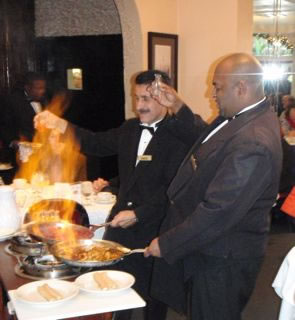 After digging into a basket of warm cinnamon-sugar bread, Steven polishes off a baked apple resting in a pool of double cream. My seafood gumbo is filled with chunks of fish and smooths out the edges of my cocktail while Fen’s Creole onion soup is velvety in texture. The Eggs Shannon feature poached eggs atop fried trout and creamy spinach and I revel in every bite; Steven orders the same dish sans spinach (dubbed Eggs St. Charles) and swears he’s picked the true winner. Fen’s Eggs Bayou LaForche boast the best name and are poach-y perfection astride spicy Andouille sausage. Our dessert course is a face-off between table-side preparations of Bananas Foster and strawberry crepes. The bananas win, seeing as how the dish was created in this very restaurant.
After digging into a basket of warm cinnamon-sugar bread, Steven polishes off a baked apple resting in a pool of double cream. My seafood gumbo is filled with chunks of fish and smooths out the edges of my cocktail while Fen’s Creole onion soup is velvety in texture. The Eggs Shannon feature poached eggs atop fried trout and creamy spinach and I revel in every bite; Steven orders the same dish sans spinach (dubbed Eggs St. Charles) and swears he’s picked the true winner. Fen’s Eggs Bayou LaForche boast the best name and are poach-y perfection astride spicy Andouille sausage. Our dessert course is a face-off between table-side preparations of Bananas Foster and strawberry crepes. The bananas win, seeing as how the dish was created in this very restaurant.
“Mom, Brennans’s is deliciousness!” exults Steven as his stuffed parents nod in agreement.
The Presbytere, one of a handful of buildings in the French Quarter comprising the Louisiana State Museums, is where we find “Living with Hurricanes: Katrina and Beyond,” a much-lauded exhibit on the ravages of the hurricane that blew ashore in 2005. In much the same way our son is aware of 9/11, he has a cursory understanding of Hurricane Katrina and is eager to learn more.
The tattered piano of musician Fats Domino opens the exhibit and it is a window on New Orleanians themselves: bowed but unbroken. The city’s vulnerability to hurricanes is well known and is partly due to attempts to shore up the Mississippi River that have come at the expense of the Gulf coast. When Katrina first formed on a Tuesday in August, it was a blip in south Florida. As it roared through the Gulf of Mexico days later, locals were hard-pressed to grasp the gravity of what was coming their way and, even more devastating, local, state and federal government was far too slow to act. While 1.2 million people did evacuate southeast Louisiana, the 100,000 residents who remained should not have been allowed to stay.
Huge video screens show the storm as it rages across the city, torrents of rain reaching rooftops and pummeling everything that gets in their way. The sound and fury are hard to bear yet key to understanding. A resident talks about the “ax in the attic” that locals keep on hand in the event you have to chop your way out; “Is this America?” wails another stranded resident. More video footage depicts the struggle at local hospitals without water, food or power and a Superdome absent working plumbing and mired in heat. All that said, it’s the stories of survivors and their determination to pull through that are the inspiring takeaway from this well-curated, thought-provoking exhibit.
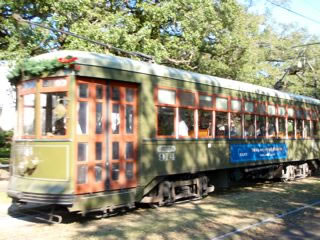 A walk from one end of the Quarter to the other puts us on Canal Street, where we hop aboard the St. Charles Streetcar for a ride to the Garden District. The narrow green car is replete with rows of caramel-colored seats and makes for a scenic ride into a neighborhood filled with gracious mansions surrounded by weeping Spanish moss.
A walk from one end of the Quarter to the other puts us on Canal Street, where we hop aboard the St. Charles Streetcar for a ride to the Garden District. The narrow green car is replete with rows of caramel-colored seats and makes for a scenic ride into a neighborhood filled with gracious mansions surrounded by weeping Spanish moss.
Back at Canal, we make our way over to the mighty Mississippi for a ride aboard the Steamboat Natchez, the last authentic steamboat plying the Mississippi. Parking ourselves on the top deck above a bright red paddle wheel, we marvel at the river as it glistens in the afternoon sunlight. Suddenly, the oft-maligned “Big Muddy” is bright blue. This is a working river, with crates and barges lifting this and dropping that along both shores. A man from Atlanta is seated next to us and takes great joy in sharing river trivia: the Mississippi River is 2,400 feet long but it’s not the longest river in the world. That honor goes to the Amazon, with ole Miss second and the Congo third (yep, the Nile is outta the top three). After a Southern buffet featuring fried chicken and bread pudding served to the strains of a jazz pianist, we step back outdoors and marvel at the restorative power of water, wind and waves.
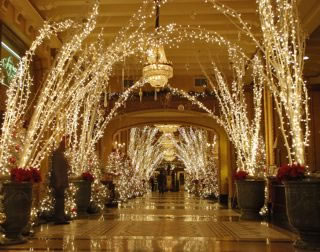 At Domenica, another John Besh restaurant, well-dressed patrons look even better in a brown-on-brown space aglow with mod chandeliers that sparkle in well-placed mirrors. Holiday decorations hang from the high-ceilinged space and add to the festive atmosphere. “This is nothing but wow!” proclaims Steven of a gorgonzola pizza with pears, pecans and speck. True enough, it’s one of many thin-crust, full-flavored pizzas on the menu that kids will love. An arugula and beet salad is utterly fresh and pasta topped with oxtail ragu and fried chicken livers is surprisingly better than the tortelloni, pockets of pasta dancing among chestnuts, squash and sage. We pronounce John Besh the king of New Orleans as we saunter out of the restaurant. Heading back to the Omni along Bourbon Street, we crane our heads into one musical venue after another, the strains of blues, jazz and rock wafting into the street. It’s a movable feast.
At Domenica, another John Besh restaurant, well-dressed patrons look even better in a brown-on-brown space aglow with mod chandeliers that sparkle in well-placed mirrors. Holiday decorations hang from the high-ceilinged space and add to the festive atmosphere. “This is nothing but wow!” proclaims Steven of a gorgonzola pizza with pears, pecans and speck. True enough, it’s one of many thin-crust, full-flavored pizzas on the menu that kids will love. An arugula and beet salad is utterly fresh and pasta topped with oxtail ragu and fried chicken livers is surprisingly better than the tortelloni, pockets of pasta dancing among chestnuts, squash and sage. We pronounce John Besh the king of New Orleans as we saunter out of the restaurant. Heading back to the Omni along Bourbon Street, we crane our heads into one musical venue after another, the strains of blues, jazz and rock wafting into the street. It’s a movable feast.
Wednesday
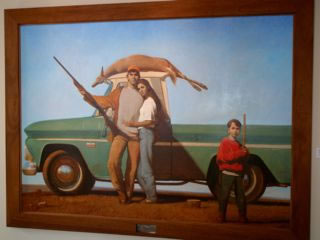 The Ogden Museum of Southern Art manages to look forward, and back, in equal measure, all the while rendering a portrait of the region that is affecting. “One Block,” a photographic exhibit by Dave Anderson, focuses of the Lower Ninth Ward, a neighborhood ravaged in the wake of Hurricane Katrina. An old fence sits alongside a new one in one photo while another shows an older woman lovingly repainting an ornate mirror. One look at the faces of these residents and you know they won’t give up.
The Ogden Museum of Southern Art manages to look forward, and back, in equal measure, all the while rendering a portrait of the region that is affecting. “One Block,” a photographic exhibit by Dave Anderson, focuses of the Lower Ninth Ward, a neighborhood ravaged in the wake of Hurricane Katrina. An old fence sits alongside a new one in one photo while another shows an older woman lovingly repainting an ornate mirror. One look at the faces of these residents and you know they won’t give up.
“Mom, the houses look so colorful!” shouts Steven from the next room as he admires the grit and elbow grease of so many in New Orleans.
Across the way is a “Rocking Horse” made of found objects that speak to “a childhood spent in poverty in southwestern Louisiana” by artist Shawne Major; another whimsical installation features to-do lists on small sheets of note paper penned by random New Orleanians. “Laundry; time for [boyfriend]; hopes and dreams,” reads one.
The museum’s three floors of gallery space showcase artists here and gone and include the Impressionistic landscapes of Robert Julian Onderdonk as well as “Walker Evans’ Louisiana: Photographs from the Collection of Jessica Lange,” a series of aching black and white portraits of faded streetscapes and plantations past their prime. Parents and kids will chuckle at “Young Life,” a gigantic painting graced by a modern-day couple with a deer atop their truck and a small boy in tow. The new American Gothic?
We abandon the youthful hunters for the swamp, specifically a Swamp & Bayou Tour. We’ve brought muffalettas from Central Grocery for the thirty-minute bus ride to the swamp and our plump sandwiches are the fortification we’ll need for a boat ride in 40 degrees.
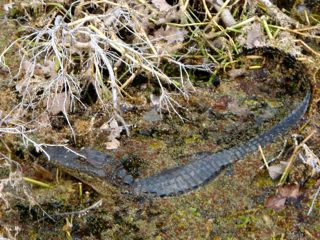 Dwarf palmetto trees, their fan-shaped leaves swaying in the breeze, line a swamp that is part of the Jean Lafitte National Park. A fellow passenger spots a great blue heron but the captain is quick to point out that we might not see gators this late in December since they lie dormant during the winter months. The average adult gator is 6-9 feet long though the swamp’s largest inhabitant, “Big Joe,” comes in at a healthy 12 feet. Steven takes it all in and, soon enough, he spots a green turtle clambering across a log and, to its right, a baby gator! Even better, we catch Big Joe in semi-slumber a short while later.
Dwarf palmetto trees, their fan-shaped leaves swaying in the breeze, line a swamp that is part of the Jean Lafitte National Park. A fellow passenger spots a great blue heron but the captain is quick to point out that we might not see gators this late in December since they lie dormant during the winter months. The average adult gator is 6-9 feet long though the swamp’s largest inhabitant, “Big Joe,” comes in at a healthy 12 feet. Steven takes it all in and, soon enough, he spots a green turtle clambering across a log and, to its right, a baby gator! Even better, we catch Big Joe in semi-slumber a short while later.
Our final dinner in New Orleans is at The Grill Room, an elegant table tucked into the Windsor Court Hotel. The restaurant is one of many in the city offering Reveillon menus, a French holiday dining tradition featuring four- and five-course prix fixe meals. We’ve chosen The Grill Room since its holiday menu is tailor-made for Steven. White bean soup with house-made Boar sausage is creamy goodness, our waiter kindly subs in a beet salad for the suggested greens and a grilled filet of Angus beef melds beautifully with Yukon gold potatoes. A bananas Foster bread pudding is the grace note that leaves us with sugarplums dancing in our heads.
Thursday
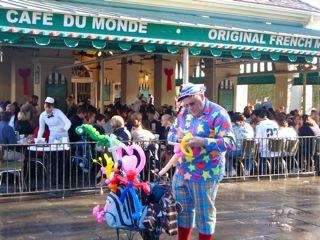 We stop at Cafe du Monde on our way out of town and snag a table straightaway. The donuts are incredible and we can see Alan Minor’s paintings from our seats opposite Jackson Square. Once done, we cross the street and Steven literally skips through the Square. Fen and I look at each other, knowingly.
We stop at Cafe du Monde on our way out of town and snag a table straightaway. The donuts are incredible and we can see Alan Minor’s paintings from our seats opposite Jackson Square. Once done, we cross the street and Steven literally skips through the Square. Fen and I look at each other, knowingly.
“We’ll be back,” I say.
Details
Omni Royal Orleans Hotel, 621 St. Louis Street (504) 529-5333 omnihotels.com Doubles from $199; package rates and Internet specials available. The Rib Room serves breakfast, lunch and dinner and Sunday Champagne Jazz Brunch; the Rib Room Bar is open nightly. A rooftop outdoor heated pool is open year round.
Cafe du Monde, 800 Decatur Street (504) 525-4544 cafedumonde.com Open 24 hours a day.
Jackson Square, bounded by Chartres, St. Peter, Decatur and St. Ann Streets in the heart of the French Quarter. Art is sold “on the fence” seven days a week.
St. Louis Cathedral, 615 Pere Antoine Alley (504) 525-9585 stlouiscathedral.org There is a concert series and tours of the cathedral are also available. Open daily.
Alan Minor, paintings and art. “On the fence” at Jackson Square across from Cafe du Monde or online at skizmart.net.
Gumbo Shop, 630 St. Peter Street (504) 525-1486 gumboshop.com Open for lunch and dinner; online store sells gumbo and spices.
Luke, 333 St. Charles Avenue (504) 378-2840 lukeneworleans.com Open daily 7 a.m.-11 p.m.
Brennan’s, 417 Royal Street (504) 525-9711 brennansneworleans.com Open seven days a week for breakfast and dinner (extended breakfast hours). Reservations essential for breakfast.
“Living with Hurricanes: Katrina and Beyond” is currently featured at the Presbytere, one of the Louisiana State Museums located at 751 Chartres Street (next door to St. Louis Cathedral). Confirm exhibit dates and times by calling (504) 568-6968. http://lsm.crt.state.la.us/katrina/index.htm
St. Charles Streetcar, from Carondelet at Canal Street through Uptown New Orleans. One-way fare is $1.25, exact change required.
Steamboat Natchez, two-hour daytime cruise or dinner cruise, both featuring live jazz. steamboatnatchez.com
Domenica, 123 Baronne Street (504) 648-6020 domenicarestaurant.com Open for brunch, lunch and dinner and the specialty pizzas can be ordered to go!
Ogden Museum of Southern Art, 925 Camp Street (504) 539-9650 ogdenmuseum.org Closed on Tuesdays, open late on Thursdays.
Swamp & Bayou Tour, operated by Gray Line Tours. Afternoon tour departs from the Gray Line Lighthouse ticket office, Toulouse Street at the Mississippi River. Reservations can be made by calling (504) 569-1401 or online at graylineneworleans.com/swamp.shtml
Central Grocery, 923 Decatur Street (504) 523-1620. Be prepared to wait at this tiny yet worthy Italian grocery store.
The Grill Room, 300 Gravier Street (504) 523-6000 grillroomneworleans.com Open for breakfast, lunch and dinner daily.
![]()
Elaine Sosa Labalme is a food and travel writer based in Pittsburgh, PA . When she's not busy as a domestic goddess she's out traveling with husband Fen and nine-year-old son Steven. She hopes to be the next Charles Kuralt.
Note: This information was accurate when it was published. Please be sure to confirm all rates and details directly with the businesses in question before making your plans.



